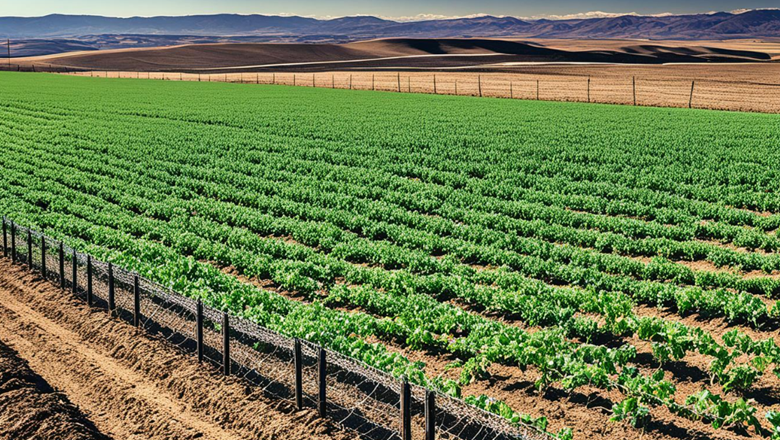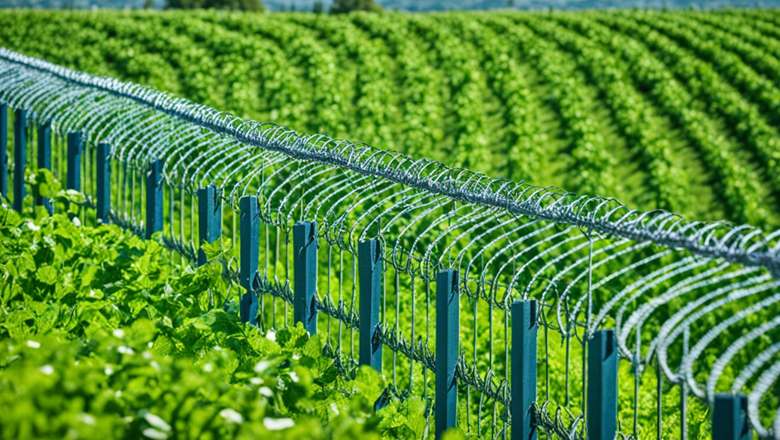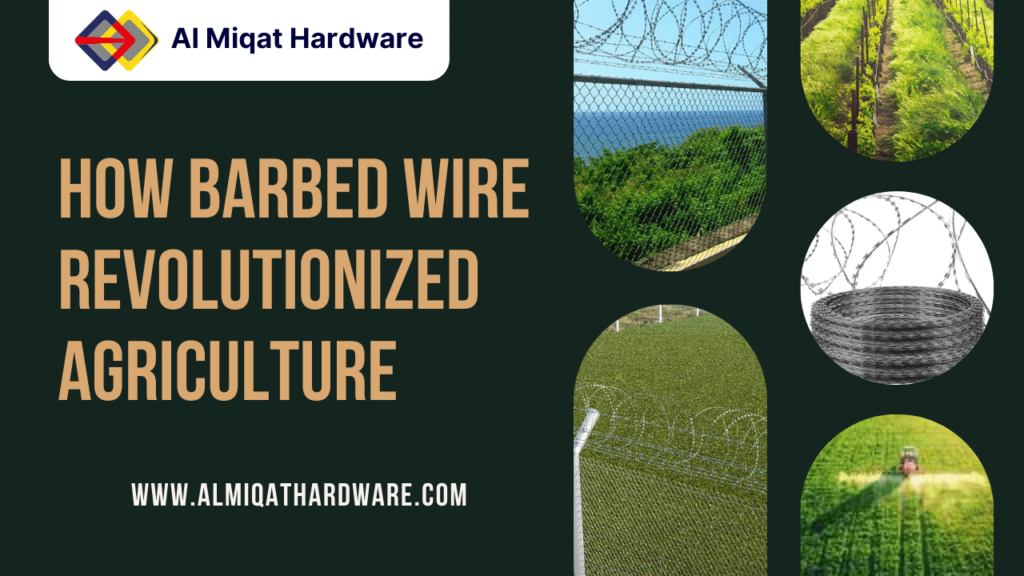Barbed wire changed farming forever by making it easier to protect land and crops. Before, farmers had a hard time keeping animals off their land. This was because fencing was hard to make and needed a lot of trees.
But when Lucien B. Smith and Joseph F. Glidden created barbed wire, everything changed. This type of fencing was new and made using less wood. It helped farmers in the American West a lot where trees were scarce.
With barbed wire, owning land was safer. This meant farmers could focus more on growing their crops. It not only boosted productivity but also made their land more valuable.
The invention of barbed wire was a big deal for farming. It not just improved how well farmers could protect their crops. It also meant better use of land and more thoughtful farming methods.
Key Takeaways
- Barbed wire provided a radical solution for property protection in agriculture.
- Lucien B. Smith and Joseph F. Glidden were pivotal in developing and popularizing barbed wire fencing.
- Barbed wire facilitated the defense of crops from livestock, leading to enhanced productivity.
- The scarcity of timber in the American West made barbed wire an essential agricultural innovation.
- The implementation of barbed wire resulted in a significant increase in land value and economic development.

The Invention of Barbed Wire
Barbed wire changed farming forever. Before its invention, farmers struggled to protect their land using wooden fences. Wood was scarce in places like the American West, making it hard to fence off fields. Barbed wire came as a simple yet effective solution to these long-standing problems.
Early Fencing Challenges
Before barbed wire, farmers used costly and labor-intensive wooden fences. The lack of timber made securing large areas of land tough. This resulted in livestock breaking through, damaging crops, and lowering productivity.
Lucien B. Smith and Joseph F. Glidden
In 1867, Lucien B. Smith patented the first barbed wire design. Later, Joseph F. Glidden enhanced Smith’s design, making it more efficient and effective. Their work transformed farming by giving farmers a durable fencing option.
Patenting Process and Commercialization
Smith and Glidden’s patenting made barbed wire widely available. Their efforts ensured the new design was protected and known everywhere. As a result, barbed wire quickly became the top choice for farmers, overcoming the timber shortage.
Barbed wire’s influence on farming was immense. It allowed farming in new, widespread areas. This led to better crop protection and increased agricultural growth.
The Economic Impact of Barbed Wire
The invention of barbed wire changed the agricultural economy in a big way. During the 1880s, when there wasn’t much forest, the value of farmland went up a lot. This jump in value, reaching over $103 million in 1880, was a big deal. It made farming easier and safer for crops, adding almost 1% to the US’ economic output back then.
Barbed wire fences helped keep cows from eating crops, which was a game-changer. It meant farmers could make their land better, knowing their crops were protected. This made farming more profitable and led to growing different, more valuable crops. This change improved farming areas’ economies even more.
Putting up barbed wire fences was a big deal but not too hard for most farmers. This made it easy for many farmers to keep their land safe from animals. It led to more investment in protecting and managing farmlands. As a result, farms became smarter and more productive, and their value went up. Barbed wire truly changed how we farm.
Transforming the American West
Barbed wire changed the American West’s look forever. It made farming easier and expanded, changing the whole region. It helped quickly create new towns and farms by keeping land safe.
Expansion of Farmland
Farmers could now protect their land more easily thanks to barbed wire. This led them to grow more crops without worrying about animals destroying their fields. As a result, more land was used for farming. This made more people move to the West and start their farms.
Shift from Hay to Valuable Crops
Farmers began growing things like corn and wheat, knowing they could keep these crops safe from animals. This change improved the environment and needed better care for the land and water. High-value crops quickly became the focus over lower-value hay because they were more protected.
Growing these valuable crops increased the West’s land values. This shift played a big part in making the West more stable and economically strong. It moved from being mainly for travelers to a place where people lived and worked.
Concertina Razor And Barbed Wire, Barbed Wire Mesh, Concertina Razor Wire Mesh in Agriculture
In farming today, we use new tools like concertina razor wire and barbed wire mesh. They change the way we protect and manage our farms. These tools help with perimeter security, keeping both animals and people out.
Farmers use concertina razor wire and barbed wire mesh to keep their animals safe. This prevents crop harm and boosts crop protection. So, these tools make farming more successful.
Concertina razor wire is a key part of modern agriculture. It’s tough and affordable. These qualities show how the use of barbed wire has evolved. Using such advanced methods keeps our farms safe and productive.
We choose these advanced fences to make sure our farms are really safe. Here are their special features:
- High durability and resistance to weather conditions
- Enhanced deterrence capability
- Effective in various terrains and environments
Introducing concertina razor wire and barbed wire mesh protects farms. This change makes modern agriculture work better. These tools show how farm fencing has advanced, keeping our lands safe and productive.

Barbed Wire’s Impact on Property Rights
Barbed wire changed the game for farmers and their land. It solved the problem of animals getting into their fields. This issue had been a big threat to crops and livelihoods. With barbed wire, farmers could clearly mark their land and keep animals out. It provided a much-needed agricultural security.
Protecting Land from Roaming Livestock
Barbed wire made a big difference in protecting fields from animals. Before, animals could freely ruin crops, causing huge financial losses. The ability to put up barbed wire made it clear which land was off-limits to animals. It helped keep crops safe and farmers’ money-making opportunities alive.
Increased Security and Investment
By adding barbed wire, farmers felt more secure about their land. They were happy their crops couldn’t be ruined by animals. This made them more willing to invest in their farms and buy more land. Barbed wire really improved how farming worked and how land was protected.
Conclusion
The impact of barbed wire on agriculture is huge. It moved us from wood to metal fences. This change showed a lot of innovation and strength. People like Lucien B. Smith and Joseph F. Glidden made this happen. They faced problems and found a long-lasting solution. This not only helped at the time but also helped farming grow and get better.
The story of barbed wire goes beyond its start. It’s about more than just fencing. It stands for how we strive for better ways and more success in farming. Barbed wire made things safer and led to more investments. This made the economy grow. It also made sure land rights were protected and farms could work better.
Looking back, we see how barbed wire shapes today and tomorrow. We now have new types like mesh and razor wire. These show that we are still finding better ways to fence for farming. This keeps our land safe and helps farming be as good as it can be. Barbed wire’s journey is about finding smart solutions. It’s a story of always trying to do better in farming. This tells us a lot about our creativity and wish for a bright farming future.
FAQ
How did barbed wire revolutionize agriculture?
Barbed wire changed farming by being an affordable way to protect crops and show property lines. It let farmers keep livestock away from their crops, adding value to their land.
Who were the key inventors behind barbed wire?
Lucien B. Smith and Joseph F. Glidden were the main creators of barbed wire. Smith first made it in 1867. Glidden later made it better for farming and available to many more people.
What were the challenges with early fencing methods before barbed wire?
Early fences were mainly made of wood. They were hard to build and used a lot of resources. This was a big problem in places where trees were rare, like the American West.
How did the commercialization of barbed wire impact agriculture?
Selling barbed wire changed farming a lot. It made fencing cheap and easy. This helped land values go up and crops grow better. So, the use of barbed wire really changed how farming looked.
What economic benefits did barbed wire bring to farmers?
Barbed wire made farming more profitable in many ways. It raised the value of lands by allowing farmers to protect their crops. It lessened the harm done by livestock and made it easier to invest in the land.
How did barbed wire contribute to the transformation of the American West?
Barbed wire was key to opening more farming in the American West. It let farmers use their land better and grow more valuable crops. This led to economic growth in the West.
What advancements in fencing materials have been made since barbed wire?
After barbed wire, new fencing materials were developed. These include razor wire and more secure fencing. They help protect both farm animals and the land from unauthorized entry.
How did barbed wire impact property rights within the agricultural sector?
Barbed wire made it easier to claim and protect farmland. This encouraged farmers to invest and improve their land. In the end, it helped the agricultural economy grow stronger.


